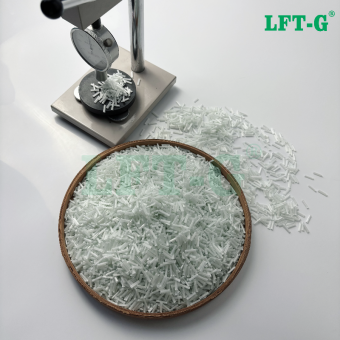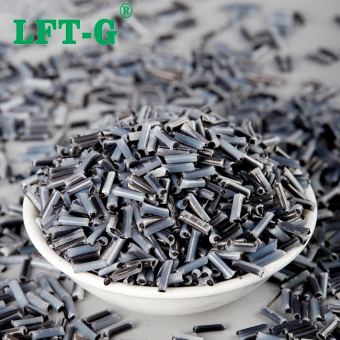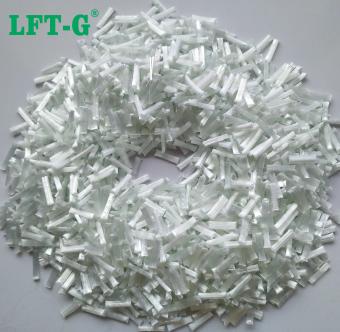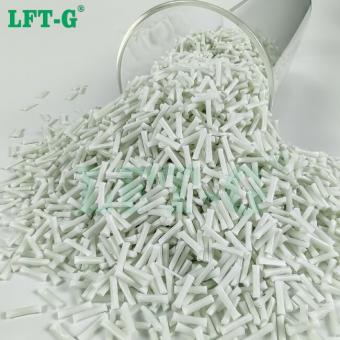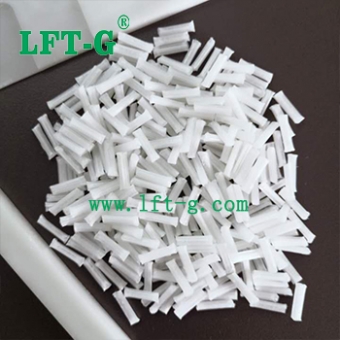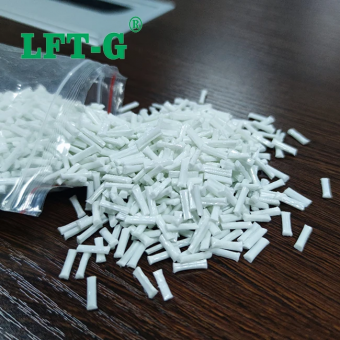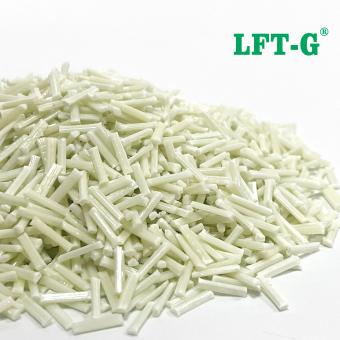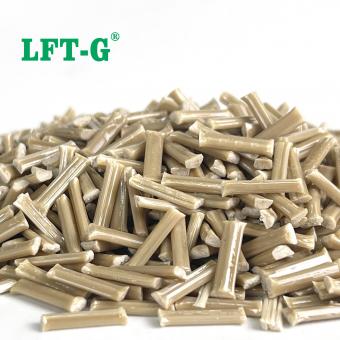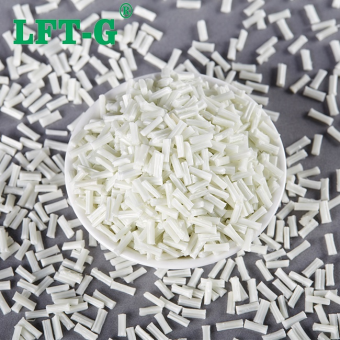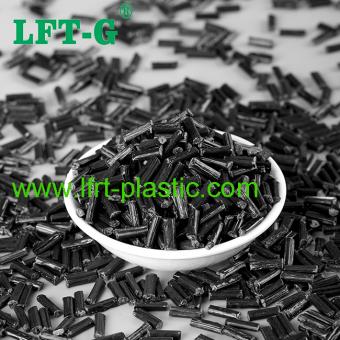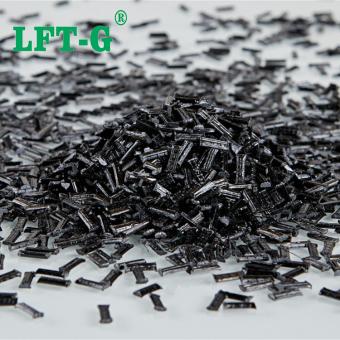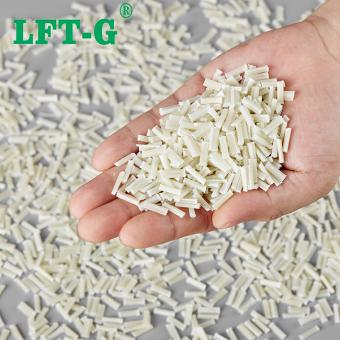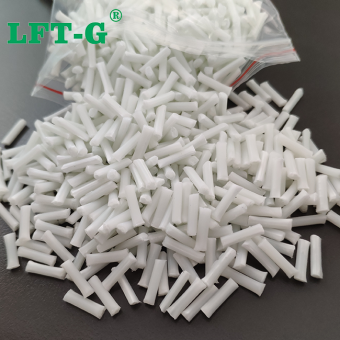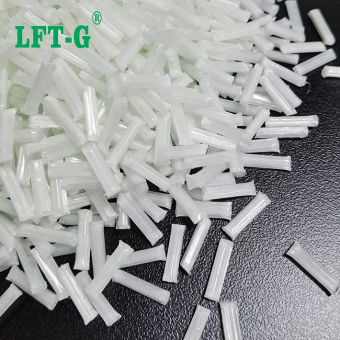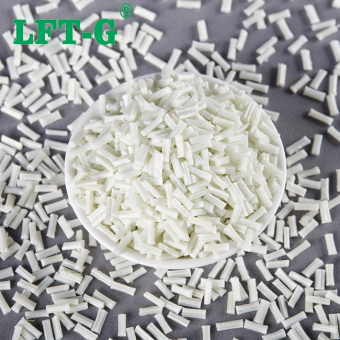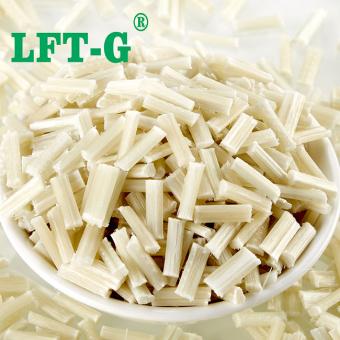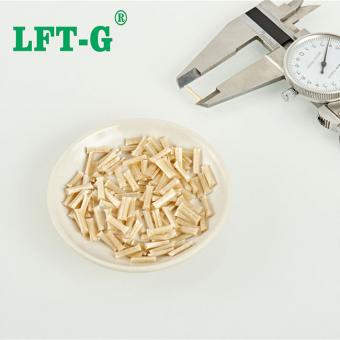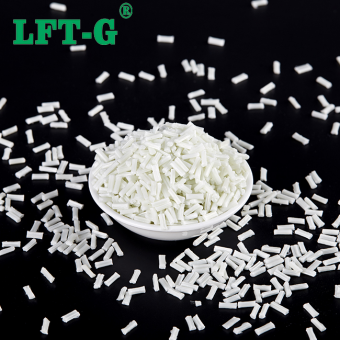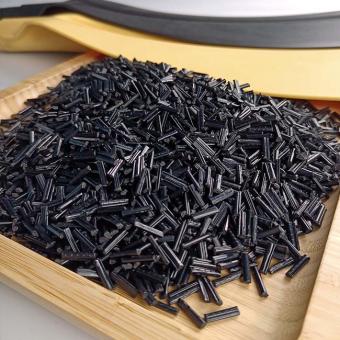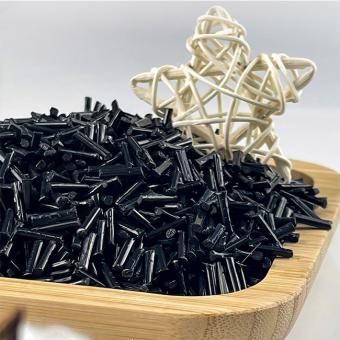-
PA6 Nylon6 Poliamida6 compuesto Fibra de vidrio larga Plástico modificado 12 mm de longitud color originalPA6 material PA6 is one of the most widely used materials in the current field, and PA6 is a very good engineering plastic with balanced and good performance. The raw materials for the manufacture of nylon 6 engineering plastic are extensive and inexpensive, and it is not restricted by the technological monopoly of foreign companies. However, in order to make good use of this inexpensive and excellent material, we must first understand it. Today, we will start with glass fiber reinforced PA6 engineering plastics, because it is the most important category of PA6 engineering plastics. Just like any other engineering plastics, PA6 has advantages and disadvantages, such as high water absorption, low temperature impact toughness and dimensional stability is relatively poor. So engineers will use different methods to make PA6 better, which we call modification. At present, the most common method is to blend and modify PA6 with glass fiber (GF). Today, we will take a look at the mechanical properties of PA6 engineering plastics under the glass fiber GF system for reference and help us select materials. PA6-LGF 1. Influence of glass fiber content on PA6 engineering plastics We can find from the application and experiment that the content index is often one of the biggest influencing factors in fiber reinforced composites. As the glass fiber content increases, the number of glass fibers per unit area of the material will increase, which means that the PA6 matrix between the glass fibers will become thinner. This change determines the impact toughness, tensile strength, bending strength and other mechanical properties of glass fiber reinforced PA6 composites. In terms of impact performance, the increase of glass fiber content will greatly increase the notch impact strength of PA6. Taking long glass fiber (LGF) filling PA6 as an example, when the filling volume increases to 35%, the notch impact strength will increase from 24.8J/m to 128.5J/m. But the glass fiber content is not more is better, short glass fiber (SGF) filling volume reached 42%, the impact strength of the material reached the highest 17.4kJ/㎡, but continue to add will let the gap impact strength showed a downward trend. In terms of bending strength, the increase of the amount of glass fiber will make the bending stress can be transferred between the glass fiber through the resin layer; At the same time, when the glass fiber is extracted from the resin or broken, it will absorb a lot of energy, thus improving the bending strength of the material. The above theory is verified by experiments. The data show that the bending elastic modulus increases to 4.99GPa when the LGF (long glass fiber) is filled to 35%. When the content of SGF (short glass fiber) is 42%, the bending elastic modulus reaches 10410MPa, which is about 5 times that of pure PA6. 2. Influence of glass fiber retention length on PA6 composites The fiber length of the glass fiber also has an obvious effect on the mechanical properties of the material. When the length of the glass fiber is less than the critical length (the length of the fiber when the material has the tensile strength of the fiber), the interface binding area of the glass fiber and the resin increases with the increase of the length of the glass fiber. When the composite material is broken, the resistance of the glass fiber from the resin is also greater, so as to improve the ability to withstand the tensile load. When the length of glass fiber exceeds the critical, the longer glass fiber can absorb more impact energy under impact load. In addition, the end of the glass fiber is the initiation point of crack growth, and the number of long glass fiber ends is relatively less, and the impact strength can be significantly improved. The experimental results show that the tensile strength of the material increases from 154.8MPa to 164.4MPa when the glass fiber content is kept at 40% and the length of the glass fiber increases from 4mm to 13mm. The bending strength and notched impact strength increased by 24% and 28%, respectively. Además, la investigación muestra que cuando la longitud original de la fibra de vidrio es inferior a 7 mm, el rendimiento del material aumenta de manera más evidente. En comparación con la fibra de vidrio corta, el material PA6 reforzado con fibra de vidrio larga tiene una mejor apariencia de resistencia a la deformación y puede mantener mejor las propiedades mecánicas en condiciones de alta temperatura y humedad. TDS para su referencia PA6 se puede convertir en material reforzado con fibra de vidrio larga agregando un 20% -60% de fibra de vidrio larga según las características del producto. PA6 con fibra de vidrio larga añadida tiene mejor fuerza, resistencia al calor, resistencia al impacto, estabilidad dimensional y resistencia a la deformación que sin fibra de vidrio añadida. Los siguientes TDS muestran los datos de PA6-LGF30. Solicitud PA6-LGF tiene la mayor proporción de aplicaciones en la industria...
- Materiales de resina termoplástica PA6
- nailon 6 gránulos
- gránulos de plástico reforzado con fibra de vidrio
- compuestos de fibra larga pa6
- Moldeo por inyección de plástico
- Material reforzado LFT-G
Etiquetas :
-
LFT-G PA66 Compuesto de Nylon66 Fibra de carbono larga 20% -60% Moldeo por inyección de mayor rendimientoPolyamide series Nylon is the common name of polyamide (PA), is the general term for thermoplastic resins containing repeated amide groups on the main chain of the molecule, including aliphatic polyamide, aliphatic aromatic polyamide and aromatic polyamide. As the first of the five engineering plastics, nylon has an extremely wide range of industrial applications, mainly used in automotive parts, mechanical parts, electronic and electrical appliances, cosmetics, adhesives and packaging materials and other fields. Among them, aliphatic polyamide, mainly nylon 66, is the most productive and widely used. Polyamide66 Nylon 66 (PA66) is a kind of polyamide formed by the condensation of adipic acid and adipdiamine. The molecular formula is shown in the figure Advantages: high strength, corrosion resistance, good wear resistance, and has self-lubrication, flame retardant, non-toxic environmental protection and other excellent performance. Disadvantages: poor heat and acid resistance, low impact strength in dry state and low temperature, water absorption greatly affects the dimensional stability and electrical properties of products. Long carbon fiber filling PA6 Long carbon fiber is an inorganic polymer material with more than 90% carbon content, which is obtained by carbonization and graphitization of organic fibers. The microstructure of long carbon fiber is similar to that of artificial graphite (C atoms arranged in layers). Advantages: light weight, high strength, high modulus, high temperature resistance, wear resistance, corrosion resistance, fatigue resistance, electrical and thermal conductivity, etc. Disadvantages: high cost, relatively difficult to infiltrate, poor transparency, defects difficult to check, etc. According to the source of carbon fiber, long carbon fiber can be divided into: Polyacrylonitrile-based long carbon fiber Asphaltic long carbon fiber Viscosified long carbon fiber Long carbon fiber composite material is a very useful structural material, it is not only light, high temperature resistance, but also has a high tensile strength and elastic modulus, is the manufacturing of spacecraft, rockets, missiles, high-speed aircraft and large passenger aircraft indispensable components of the material. It is also widely used in transportation, chemical industry, metallurgy, construction and other industrial sectors as well as sports equipment. Datasheet for reference The density of A66/CF composite material is less than 1.3, which is less than one sixth of the density of steel (7.85), achieving the purpose of lightweight, which is conducive to energy saving and consumption reduction. In the PA66/CF composite system, the length of CF is about 0.5 ~ 0.7mm, the interface between PA66 matrix and carbon fiber is fully combined, and nylon 66 is well wrapped around carbon fiber. The fracture surface of PA66/CF sample is rough, and the PA66/CF composite is a ductile material. Compared with PA66, the mechanical properties of PA66/CF composites are significantly improved. Trade fairs we attended Xiamen LFT composite plastic Co., Ltd. es una empresa de marca que se enfoca en LFT y LFRT. Serie de fibra de vidrio larga (LGF) y serie de fibra de carbono larga (LCF). El termoplástico LFT de la compañía se puede usar para moldeo por inyección y extrusión LFT-G, y también se puede usar para moldeo LFT-D. Se puede producir de acuerdo con los requisitos del cliente: 5~25 mm de longitud. Los termoplásticos reforzados con infiltración continua de fibra larga de la compañía han pasado la certificación del sistema ISO9001 y 16949, y los productos han obtenido muchas marcas comerciales nacionales y muchas patentes.
- "Compuesto LFT"
- largo fibra de carbono poliamida pa66
- gránulos de plástico reforzado con fibra de carbono
- compuestos de fibra larga pa66
- pa66 lcf30
- gránulos pa66 compuestos de fibra larga
Etiquetas :
-
LFT PPS Material compuesto de fibra de carbono largo reforzado con plástico lcf de alta tenacidad para automóvilesMateriales PPS-LCF El sulfuro de polifenileno (PPS) es un polímero semicristalino lineal con anillo de benceno y átomos de azufre compuesto por una cadena principal molecular, su punto de fusión es de aproximadamente 280 ℃ y tiene muchas características excelentes, con una serie de excelentes propiedades, como excelentes propiedades mecánicas , estabilidad química, resistencia a los solventes, retardante de llama y tiene buenas propiedades de procesamiento y moldeo. Como un tipo de plástico de ingeniería especial con la mayor producción en la actualidad, la base de aplicación del mercado está madura. Además, en el proceso de moldeo, se pueden procesar moldeo por pultrusión, moldeo por inyección, moldeo y otros métodos. Al reforzar la resina PPS con fibra de carbono, se pueden preparar compuestos con excelentes propiedades mecánicas y resistencia al calor. En la actualidad, los materiales compuestos reforzados con fibra de PPS se han utilizado ampliamente en el campo aeroespacial. Tencate Company de los Estados Unidos utiliza la resina PPS de la marca Fortron de la compañía Ticona de Alemania para producir compuestos de fibra de carbono/PPS basados en el método de moldeo por prensado en caliente de tela. El material se utiliza en el borde principal del ala del avión Airbus A340 y A380, la estructura del alerón del avión A340, la viga y la costilla de tensión de la puerta del tren de aterrizaje del avión Fokker50, la cola del avión de negocios G650, el timón y los componentes del elevador. Ventajas Performance characteristics: ◊ receiving aerospace OEM specifications and receiving certification; ◊ excellent cost performance; ◊ Working temperature exceeding Tg according to the design requirements on parts; ◊ laminates can protect against lightning strike and electrochemical corrosion. ◊ inherent flame retardant ◊ excellent chemical stability and solvent resistance; ◊ Long-term storage at ambient temperature. Main applications: ◊ Major and minor aircraft structures: ◊ wing leading edge, engine tower, body splint structure, etc. ◊ aircraft interior structure: ◊ seat structure parts, trunk, etc ◊ On specific requirements on corrosion resistance, dimensional stability, and shock absorption on high-end industrial areas Application Proceso de producción Nuestro equipo y clientes ¡Ven y contáctanos!
- termoplásticos reforzados con fibras largas
- PPS reforzado con fibra de carbono larga
- ppslcf30
- compuestos de fibra larga pps
- LFT de pps
Etiquetas :
-
lft-g PA66 material reforzado fibra de vidrio larga 30% especificación Poliamida66 plástico modificado¿Qué es PA66? PA66, abreviatura de Poliamida 66, nombre químico poliadiptil adiptil diamina, comúnmente conocido como nylon 66. Es un polímero termoplástico semicristalino transparente e incoloro, ampliamente utilizado en automóviles, aparatos electrónicos, instrumentos mecánicos, piezas industriales y otras industrias. ¿Qué es PA66-LGF? Sin embargo, debido a la gran absorbencia del propio nailon, la escasa resistencia a los ácidos, la baja resistencia al impacto del estado seco y la baja temperatura, y la fácil deformación después de la absorción de agua, la estabilidad dimensional del producto se ve afectada, por lo que su rango de aplicación se limita a algunos medida. Con el fin de mejorar las deficiencias anteriores, ampliar su campo de aplicación y cumplir mejor con los requisitos de rendimiento, las personas adoptan una variedad de métodos para modificar el plástico PA66, a fin de mejorar la propiedad de impacto, la propiedad de deformación térmica, la propiedad de procesamiento de formación y la corrosión química. resistencia. Debido a que la resistencia específica y el módulo de Young de la fibra de vidrio (LGF) son 10~20 veces mayores que los de PA66, el coeficiente de expansión lineal es aproximadamente 1/20 del PA66, la absorción de agua es cercana a cero y tiene buena resistencia al calor y a los productos químicos, el relleno de fibra de vidrio es el método de modificación de mejora más utilizado de PA66. PA66 es la variedad de mayor resistencia mecánica y la más utilizada en la serie PA. Debido a su alta cristalinidad, tiene una gran rigidez y resistencia al calor. TDS Polímero cristalino opalescente translúcido u opaco con plasticidad. Posee excelente resistencia al desgaste, auto lubricidad y alta resistencia mecánica. Solicitud 1. La industria del automóvil Because of its excellent heat resistance, chemical resistance, strength and convenient processing, nylon 66 has been widely used in the automobile industry. At present, it can be used in almost all parts of the automobile, such as the engine parts, electrical parts and body parts. The engine part includes the intake system and the fuel system, such as the engine cylinder head cover, throttle, air filter machine housing, vehicle air horn, vehicle air conditioning hose, cooling fan and its housing, water inlet pipe, brake oil tank and cover, and so on. Body parts include: car fender, rear view mirror frame, bumper, dashboard, luggage rack, door handle, wiper bracket, seat belt buckle, interior decoration and so on. Car electric appliances such as electric control doors and Windows, connectors, crisper, cable tie wire. 2. Electronic and Electrical industries PA66 can produce electronic and electrical insulation parts, precision electronic instrument parts, electrical lighting appliances and electronic and electrical parts, can be used to make rice cookers, electric vacuum cleaners, high-frequency electronic food heaters, etc. PA66 has excellent solder resistance and is widely used in the production of junction boxes, switches and resistors. Flame retardant grade PA66 can be used for color TV wire clip, fixing clip and focusing knob. 3. Machinery transportation and machinery and equipment industry PA66 can be used for door handles of passenger cars and brake joint discs of freight cars. Other products such as insulation washer, baffle seat, turbine, propeller shaft, screw propeller and sliding bearing on ship can also be made with PA66. High impact resistance nylon 66 can also be made pipe pliers, plastic molds, radio control body, etc. Unreinforced grade nylon 66 is usually used to manufacture nuts, bolts, screws, nozzles, etc. with low creep and no corrosion. Reinforced grade nylon 66 used in the production of chains, conveyor belts, fan blades, impeller and scaffolding fixed foot buckle. Details Number Color Length MOQ Package Sample Delivery time Port of Loading PA66-NA-LGF30 Original color 12mm 25kg 25kg/bag Available 7-15 days after shipment Xiamen Port Frequently asked questions 1. How to choose the fiber content of the product? Is the larger product suitable for higher fiber content material? A. This is not absolute. The content of glass fiber is not more is better. The suitable content is just to meet the requirements of each products. 2. Can products with appearance requirements be made of long-fiber materials? A. The main feature of LFT-G thermoplastic long glass fiber and long carbon fiber is to show the mechanical properties. If the customer has bright or other requirements for the appearance of the product, it needs to be evaluated in combination with specific products. 3. How to choose the reinforcement method and length of the material when using long fiber reinforced thermoplastic material? A. The selection of materials depend on the requirements of the products. It is necessary to assess how much the content is enhanced and how much length is more appropriate, which are depending on the performance requirements of the prod...
- Poliamida 66 lgf relleno lgf
- fibra de vidrio larga poliamida66
- pa66 lgf30
- poliamida 6.6 lgf30
Etiquetas :
-
LFT-G Acrilonitrilo Butadieno Estireno ABS materias primas relleno fibra de vidrio larga plástico modificado 12mm¿Qué es ABS? El ABS (ABS es el acrónimo de copolímero de acrilonitrilo butadieno estireno), también conocido como resina ABS, es un tipo de material estructural de polímero termoplástico con alta resistencia, buena tenacidad y fácil de mecanizar. La apariencia del plástico de ingeniería ABS es de grano de marfil opaco, sus productos pueden ser coloridos y tienen un alto brillo. ¿Por qué llenar fibra de vidrio larga? LFT y LFRT, los plásticos de ingeniería termoplásticos reforzados con fibras largas, en comparación con los termoplásticos reforzados con fibras cortas convencionales, suelen tener una longitud de fibra de menos de 1 a 2 mm en los termoplásticos reforzados con fibras cortas convencionales, mientras que el proceso LFT los plásticos de ingeniería termoplásticos producidos han sido capaces para mantener longitudes de fibra por encima de 5 a 25 mm. La fibra larga se impregna con un sistema de resina especial para obtener una tira larga que se humedece lo suficiente con la resina y luego se corta en la longitud deseada según sea necesario. De acuerdo con las diferentes aplicaciones finales, el producto terminado puede usarse para moldeo por inyección, extrusión y moldeo, etc., directamente para reemplazar productos de acero y termoestables. Ventajas de ABS-LGF 1 reforzado con fibra de vidrio, la fibra de vidrio es un material resistente a altas temperaturas, por lo tanto, la temperatura resistente al calor del plástico reforzado es mucho más alta que antes sin fibra de vidrio, especialmente plásticos de nailon. 2. Después del refuerzo de fibra de vidrio, debido a la adición de fibra de vidrio, el movimiento mutuo entre las cadenas de polímeros de plástico es limitado, por lo tanto, la tasa de contracción de los plásticos reforzados disminuye mucho y la rigidez mejora considerablemente. 3. Después del refuerzo de fibra de vidrio, los plásticos reforzados no se agrietarán por estrés, al mismo tiempo, el rendimiento anti-impacto de los plásticos mejora mucho. 4. Después del refuerzo de fibra de vidrio, la fibra de vidrio es un material de alta resistencia, que también mejora en gran medida la resistencia del plástico, como: resistencia a la tracción, resistencia a la compresión, resistencia a la flexión, mejora mucho. 5. Fibra de vidrio reforzada después, debido a la adición de fibra de vidrio y otros aditivos, el rendimiento de combustión de los plásticos reforzados disminuyó mucho, la mayor parte del material no puede encenderse, es un tipo de material ignífugo. Hoja de datos para referencia Aplicación de ABS-LGF Se utiliza principalmente en piezas de carga y piezas estructurales. Detalles que te puedes preguntar Número Longitud Color MOQ Paquete Muestra tiempo de entrega Puerto de carga ABS-NA-LGF30 5~25MM arriba Color original (se puede personalizar ) 25kg 25kg/bolsa Disponible 7~15 días después del envío Puerto de Xiamen nuestra empresa Nuestros equipos y clientes Le ofreceremos : _ 1. Parámetros técnicos del material LFT y LFRT y diseño de vanguardia. 2. Diseño del frente del molde y recomendaciones. 3. Brindar soporte técnico, como moldeo por inyección y moldeo por extrusión.
- fibra de vidrio larga Acrilonitrilo Butadieno Estireno
- compuestos de fibra larga ABS
- gránulos de ABS compuesto de fibra larga
- ABS LGF30
- fibra de vidrio abs
Etiquetas :
-
LFT-G Relleno de plástico reforzado con PP fibra de vidrio larga 20%-60% resina termoplástica lgf de alto rendimientoPP material Polypropylene, PP for short, is a polymer of propylene by adding polymerization. White waxy material, transparent and light in appearance. Polypropylene is a thermoplastic synthetic resin with excellent properties. It is a colorless translucent thermoplastic lightweight general plastic with chemical resistance, heat resistance, electrical insulation, high strength mechanical properties and good high wear-resisting machining properties. PP-LGF material PP plus glass fiber is by adding glass fiber reinforced PP material, due to the addition of glass fiber, limited the mutual movement between polymer chains of PP plastic, therefore, the shrinkage rate of glass fiber reinforced PP (PP plus glass fiber) decreases, rigidity, impact resistance, tensile strength, compression strength, bending strength and flame retardant are improved. The mechanical properties of PP plus glass fiber specifically, tensile strength reached 65MPa--90MPa, bending strength reached 70MPa--20MPa, bending modulus reached 3000MPa--4500MPa, such mechanical strength can be completely comparable with ABS and enhanced ABS products, and more heat resistant. Generally, the heat resistance temperature of ABS and reinforced ABS is between 80℃--98℃, and the heat resistance temperature of glass fiber reinforced PP material can reach 135℃--145℃, and even 150 degrees can withstand more than 1000 hours. Compared with SGF(Short Glass Fiber) TDS for reference only Aplicación de PP-Fibra de vidrio larga El relleno de PP de fibra de vidrio larga se puede utilizar para fabricar refrigeradores, aire acondicionado y otras máquinas de refrigeración en el ventilador de flujo axial y el ventilador. Además, también se puede utilizar para fabricar el tambor interior de la lavadora de alta velocidad, la rueda ondulada, la rueda de la correa para adaptarse a sus requisitos de alto rendimiento mecánico, se utiliza para la base y el mango de la olla arrocera, el horno de microondas electrónico y otros lugares con alta temperatura. requisitos de resistencia, en términos generales, la mayoría de los materiales de PP reforzados con fibra de vidrio se utilizan en las partes estructurales del producto, es un tipo de materiales de ingeniería estructural. Casos piezas de lavadora Partes delanteras de automóviles Piezas de scooter Preguntas frecuentes 1. ¿La inyección de fibra de vidrio larga tiene requisitos especiales para las máquinas y moldes de moldeo por inyección? R. Ciertamente hay requisitos. Especialmente desde la estructura del diseño del producto, así como la boquilla del tornillo de la máquina de moldeo por inyección y el proceso de moldeo por inyección de la estructura del molde, se deben considerar los requisitos de fibra larga. 2. Después de un largo refuerzo con fibra de vidrio, la fibra de vidrio puede ingresar a la superficie del producto de plástico durante el proceso de moldeo por inyección, de modo que la superficie del producto se vuelve fibra áspera y flotante. ¿Cómo hacer que la superficie del material sea suave? A. Durante el proceso de moldeo por inyección, debe asegurarse de que las partículas de plástico estén bien plastificadas y dispersas, también asegúrese de que el secado de las partículas de plástico no elimine la humedad, el ajuste de la temperatura del molde a la temperatura adecuada, la superficie del molde esté pulida en su lugar. 3. ¿Pueden fabricarse productos con requisitos de apariencia con materiales de fibra larga? A. La característica principal de la fibra de vidrio larga termoplástica LFT-G y el carbono largo es mostrar las propiedades mecánicas. Si el cliente tiene requisitos de brillo u otros para la apariencia del producto, debe evaluarse en combinación con productos específicos,
- compuestos de fibra larga pp
- páginas lgf40
- polipropileno de fibra de vidrio larga
- gránulos de PP compuesto de fibra larga
- PP LFT
Etiquetas :
-
Compuestos de fibra de vidrio larga de poliamida6 PA6 de alta tenacidad para electrodomésticos, herramientas eléctricasPA6-LGF Los plásticos modificados con PA6 toman una porción de PA6 pura como matriz y mejoran las propiedades internas y externas a través de la mezcla, el relleno, el fortalecimiento, la copolimerización, la reticulación y otros métodos, lo que representa aproximadamente el 15 % del campo de aplicación de PA6. El contenido de fibra de vidrio larga es del 20 % al 60 %, y el contenido de fibra de vidrio larga se controla de acuerdo con las diferentes características del producto. Tiene las características de alta resistencia, resistencia superior al calor, buena resistencia al impacto y puede reemplazar el peso ligero de algunos materiales metálicos. Es ampliamente utilizado en carcasas de herramientas eléctricas, herramientas de jardín, engranajes, equipos deportivos, autopartes, etc. Otras especificaciones de PA6-LGF PA6 ignífugo PA6 material has poor flame retardant performance and belongs to flammable materials, but flame retardants can change the combustion characteristics of polymers. Through mechanical mixing method, flame retardants are added to the master material to change the flammable characteristics. The products are divided into: nitrogen flame retardants, phosphorus flame retardants, environmental protection bromine flame retardants, mineral filled flame retardants, which can be used in switches, low-voltage electrical housing, wiring terminals, circuit breakers, etc. Toughen PA6 Mixed with an appropriate amount of toughening agent, the product has the characteristics of low temperature resistance, high flexibility, high fluidity, low shrinkage, low water absorption, high impact resistance, aging resistance and so on. It can be used for baby carriage parts, rolling belts, line clips, connectors and so on. Application In addition to the above applications, in high-end fields such as rail transit, medical treatment, military industry and aerospace, nylon 6 modified plastics are used more and more widely, and PA6 modified plastics are used everywhere in daily life. TDS for reference Nylon reinforced material is made of PA6/PA66 resin as the base material and adding a certain proportion of glass fiber modification. Because nylon itself is not strong enough, by adding 20 to 60 percent of the fiber, to increase its strength. In particular, 30% strength is considered the most appropriate ratio. Also added to 40-50%, according to the specific requirements of different products, coupled with the appropriate formula, can be successful. Advantage of Long glass fiber compounds 1. After glass fiber reinforcement, glass fiber is a high temperature resistant material, therefore, the heat resistance temperature of reinforced plastics is much higher than before without glass fiber, especially nylon plastics; 2. After glass fiber reinforcement, due to the addition of glass fiber, limited the mutual movement between polymer chains of plastics, therefore, the shrinkage rate of reinforced plastics decreases a lot, rigidity is greatly improved; 3. After glass fiber reinforcement, the reinforced plastic will not stress crack, at the same time, the anti-impact performance of plastic is improved a lot; 4. After glass fiber reinforcement, glass fiber is a high strength material, which also greatly improves the strength of plastic, such as: tensile strength, compression strength, bending strength, improve a lot; 5. glass fiber reinforced after, due to the addition of glass fiber and other additives, the combustion performance of reinforced plastics decreased a lot, most of the material can not ignite, is a kind of flame retardant material. Xiamen LFT composite plastic Co., Ltd. Xiamen LFT composite plastic Co., Ltd. is a brand-name company that focuses on LFT&LFRT. Long Glass Fiber Series (LGF) and Long Carbon Fiber Series (LCF). The company's thermoplastic LFT can also be used for LFT-D molding. It can be produced according to customer requirements: 5~25mm length. The company's long-fiber continuous infiltration reinforced thermoplastics have passed ISO9001&16949 system certification, and the products have obtained lots of national trademarks and patents.ver más
-
LFT marca HDPE relleno de fibra de vidrio larga plástico compuesto lgf alta dureza para piezas estructuralesWhat is HDPE? High density polyethylene (HDPE) is a white powder or granular product. Non-toxic, tasteless, crystallinity is 80% ~ 90%, softening point is 125 ~ 135℃, the use of temperature can reach 100℃; The hardness, tensile strength and creep property are better than low density polyethylene. Good wear resistance, electrical insulation, toughness and cold resistance; Good chemical stability, at room temperature, insoluble in any organic solvent, acid, alkali and all kinds of salt corrosion resistance; Thin film to water vapor and air permeability is small, low water absorption; Poor aging resistance, environmental stress cracking resistance is not as good as low density polyethylene, especially thermal oxidation will reduce its performance, so the resin must be added in antioxidants and ultraviolet absorbent to improve this deficiency. Filling Long glass fiber The tensile strength of polyethylene can be improved obviously when the amount of glass fiber is 30% ~ 40%. With the continuous increase of the addition amount, the increase of tensile strength did not change significantly, but tended to be stable. The addition amount of glass fiber has a great influence on the elastic modulus of polyethylene plastic materials. With the increase of glass fiber addition amount, the elastic modulus of polyethylene plastic materials will continue to increase and reach a certain value. La adición de fibra de vidrio tiene un gran efecto sobre el alargamiento a la rotura de los materiales plásticos de polietileno. Con el aumento de la adición de fibra de vidrio, el alargamiento a la rotura de los materiales plásticos de polietileno seguirá disminuyendo. Hasta cierto valor, la fragilidad del polietileno modificado con fibra de vidrio será más evidente, casi igual a la fragilidad de la fibra de vidrio. TDS para su referencia Solicitud Fábrica Almacén y paquete Equipos y Clientes Te ofreceremos: 1. Parámetros técnicos del material LFT y LFRT y diseño de vanguardia. 2. Diseño del frente del molde y recomendaciones. 3. Brindar soporte técnico, como moldeo por inyección y moldeo por extrusión.
- Fibra de vidrio larga Polietileno de alta densidad
- compuestos de fibra larga HDPE
- PEHD LFT
- Pellet de fibra larga de HDPE
- HDPE de fibra de vidrio
Etiquetas :
-
Relleno de plástico Xiamen LFT-G PPS Fibra de vidrio larga 94-VO Compuesto LGF ignífugo 12 mm más o menosPPS La estructura molecular de PPS consiste en un anillo de benceno y átomos de azufre interdispuestos, la configuración es ordenada, fácil de formar una alta estabilidad térmica de la estructura cristalina. Al mismo tiempo, la estructura molecular del material de PPS tiene características de enlace químico altamente estables, la estructura del anillo de benceno hace que el PPS sea más rígido y el enlace de éter de azufre (-S-) proporciona un cierto grado de flexibilidad. El PPS en sí tiene buena resistencia al calor, retardante de llama, resistencia química, debería ser un material prometedor, pero el PPS sin modificar tiene algunos defectos inevitables: Procesamiento difícil: This is the biggest pain point of all high temperature resistant materials -- high processing temperature, no matter the molding process or processing energy consumption, will face great challenges. In addition, PPS is still prone to thermal oxidation crosslinking in the melting process, resulting in reduced fluidity and further improve the processing difficulty; Poor toughness: PPS molecular chain is rigid, the maximum crystallinity is as high as 70%, the elongation is low and the welding strength is not so good. As a result, the impact resistance of unmodified PPS is poor, which limits the application scope. High cost: PPS raw materials and general engineering plastics compared, the price is about 1-2 times higher, and some modified materials compared with low cost performance; Difficult coating: PPS surface coating and coloring performance is not ideal. While this is not a major problem for now, it is a limiting factor. PPS-LGF Long glass fiber reinforced composites can solve your problems when other methods of reinforced plastics do not provide the performance you need or if you want to replace metal with plastic. Long glass fiber reinforced composites can cost-effectively reduce the cost of goods and effectively improve the mechanical properties of engineering polymers, and increase the durability by forming long fibers to form a long-fiber-reinforced internal skeleton network. Performance is preserved in a wide range of environments. TDS para referencia Solicitud Sobre nosotros Xiamen LFT composite plastic Co., Ltd. es una empresa de marca que se enfoca en LFT y LFRT. Serie de fibra de vidrio larga (LGF) y serie de fibra de carbono larga (LCF). El termoplástico LFT se puede usar para moldeo por inyección y extrusión LFT-G, y también se puede usar para moldeo LFT-D. Se puede producir de acuerdo con los requisitos del cliente: 5 ~ 25 mm de longitud. Los termoplásticos reforzados con infiltración continua de fibra larga de la compañía han pasado la certificación del sistema ISO9001 y 16949, y los productos han obtenido muchas marcas comerciales y patentes nacionales.
- sulfito de polifenileno de fibra de vidrio larga
- pps lgf30
- gránulos de pps compuestos de fibra larga
- sulfito de polifenileno reforzado con fibra de vidrio larga
Etiquetas :
-
LFT-G PA12 Relleno de Poliamida12 Compuestos largos de fibra de vidrio de alta rigidez y tenacidadPA12 PA12 polyamide or nylon 12 Chemical and physical properties of PA12 PA12 is a linear, semi-crystalline - crystalline thermoplastic material from butadiene. Its properties are similar to PA11, but its crystal structure is different. PA12 is a good electrical insulator and will not be affected by moisture as other polyamides. PA12 has good impact resistance mechanical and chemical stability. There are many improved varieties of PA12 in terms of plasticizing and reinforcing properties. Compared with PA6 and PA66, these materials have lower melting point and density, and have very high moisture recovery. PA12 has no resistance to strong oxidizing acids. The viscosity of PA12 depends mainly on humidity, temperature and storage time. PA12 It's very liquid. The shrinkage rate of PA12 is between 0.5% and 2%, depending on the variety of PA12 material, wall thickness and other process conditions. PA12 compounds plastic Nylon glass fiber material is a kind of composite material, adding glass fiber on the basis of the original nylon material, so that the material has the following characteristics: High temperature resistance, good dimensional stability, good toughness, good insulation, corrosion resistance, high mechanical strength. LGF & SGF Compared with the short fiber, it has more excellent performance in mechanical properties. It is more suitable for large products and structural parts. It has 1-3 times higher (toughness) than short fiber, and the tensile strength (strength and rigidity) is increased by 0.5-1 times. Datasheet for reference Application ■ Power tools: cutting machine, electric saw, electric drill, Angle grinder, polishing machine, electric hammer, electric pick, hot air gun and other models; ■ Automotive industry: cooling chamber, intake manifold, frame bracket, ventilation grille, door handle, throttle body and other models; ■ Industria de maquinaria: bomba de agua, válvula de agua, cojinete, manguito del eje, engranaje, soporte y otros modelos; ■ Equipos deportivos: equipos de esquí, cochecitos de bebé, piezas de equipos de gimnasia y otros modelos; ■ Equipo de oficina: soporte de asiento, polea, eje giratorio, engranaje triturador, piezas de impresora y otros modelos; Certificación Fábrica Paquete Por qué elegirnos
- fibra de vidrio larga poliamida12
- resina termoplástica reforzada con fibra larga
- compuestos de fibra larga nylon12
- lft-g PA12 lgf
- Gránulos PA12
- Poliamida12 nailon12 plásticos
Etiquetas :
-
LFT-D PP relleno plastico reforzado fibra de carbono largo polipropileno mayor rendimiento 12mm color naturalPP material PP is a polymer made of propylene as monomer by coordination polymerization, and is one of the five major general-purpose plastics PE, PP, PVC, PS and ABS. 1. colorless, tasteless, five toxic, unadded PP material compounded with FDA and other food-grade material requirements; 2. due to the crystalline nature of PP, the original color milky white translucent, better transparency than PE; 3. low specific gravity of 0.9, almost one of the lightest plastics than water; 4. good toughness, especially repeated resistance to bending ability, commonly known as 100 fold rubber; 5. better heat resistance than PE, which can reach up to 120°C; 6. good resistance to hydrolysis and can be sterilized by high temperature steam 7. good chemical resistance, especially acid resistance, can be due to the storage of concentrated sulfuric acid containers; 8. outdoor use is susceptible to light, ultraviolet light and other aging. Material PP modificado El material de PP mediante el relleno de fibra de carbono puede aumentar la rigidez y el módulo del material de PP, reducir la deformación del material causada por la contracción, pero al mismo tiempo disminuye la dureza del material. Al agregar un agente anti-UV, el agente antienvejecimiento puede mejorar el rendimiento de uso en exteriores de PP, y agregar material retardante de llama puede mejorar el rendimiento de retardante de llama de PP. TDS solo como referencia SGF VS LGF Especificación de fibra de carbono larga Solicitud Procesamiento de productos te ofreceremos 1. Parámetros técnicos del material LFT y LFRT y diseño de vanguardia 2. Diseño y recomendaciones del frente del molde 3. Brindar soporte técnico, como moldeo por inyección y moldeo por extrusión.ver más
-
LFT-G PA6 LCF nylon6 relleno largo material reforzado con fibra de carbono de alta calidad para la fabricación de cascosPolyamide6 Nylon 6 (PA6) as a general engineering plastics, with light weight, wear resistance, corrosion resistance, good toughness and other characteristics, and as a common thermoplastic resin, its heating can be softened, cooling can be hardened, and can be repeatedly heated softening, cooling hardening, repeated processing characteristics. Long carbon fiber With high strength, high modulus, large specific surface area and aspect ratio, and high electrical conductivity, carbon fiber fabrics have superior mechanical properties compared to glass fiber and can provide maximum strength in the fiber direction. Carbon fiber reinforced composites are stronger than polymer matrix materials, while maintaining the advantage of light weight, and are gradually replacing traditional metal materials in the fields of electronic products, electric vehicles, medical devices, industrial equipment and sports and leisure products. LCF VS SCF Advantage of LCF (1) High strength and high toughness (2) Small coefficient of thermal expansion (3) Low hardness and light weight (4) Corrosion resistance and aging resistance (5) Temperature resistance TDS for reference Application Adecuado para la fabricación de cascos, parachoques de automóviles y brazos robóticos, etc. Certificaciones Moldeo por inyección Fábrica y almacén Equipos y Clientes Sobre nosotros Xiamen LFT composite plastic Co., Ltd es una empresa de marca que se enfoca en LFT y LFRT. Serie de fibra de vidrio larga (LGF) y serie de fibra de carbono larga (LCF). El termoplástico LFT de la compañía se puede usar para moldeo por inyección y extrusión LFT-G, y también se puede usar para moldeo LFT-D. Se puede producir de acuerdo con los requisitos del cliente: 5~25 mm de longitud. Los termoplásticos reforzados con infiltración continua de la compañía han pasado la certificación del sistema ISO9001 y 16949, y los productos han obtenido muchas marcas comerciales y patentes nacionales.ver más

 correo electrónico
correo electrónico español
español English
English français
français Deutsch
Deutsch русский
русский italiano
italiano português
português العربية
العربية 日本語
日本語 한국의
한국의 中文
中文




